Insects
Mt. Takao is considered one of the three major habitat of insects along with Minoo (Osaka prefecture) and Kibune (Kyoto prefecture) and it has long been loved by researchers of insects because of number of species and the easy access from the Metropolitan area. There are many insects first found in Mt. Takao and named after "Takao" such as Takao Shachihoko (Hiradonta takaonis Matsumura) and Takao medaka kamikiri (Stenhomalus takaosanus).
-
Favonius orientalis (Oriental Hairstreak) Lycaenidae
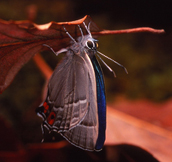
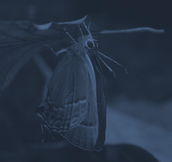 Favonius orientalis (Oriental Hairstreak) Lycaenidae
Favonius orientalis (Oriental Hairstreak) Lycaenidae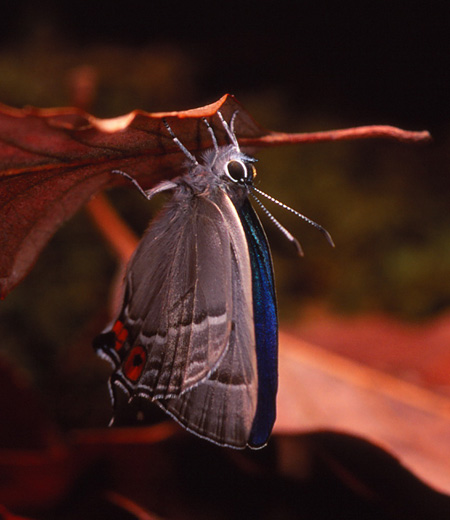 Main Region: Hokkaido, Honshu, Shikoku and some parts of Kyushu.
Main Region: Hokkaido, Honshu, Shikoku and some parts of Kyushu.
Found in woods and forests from flatlands to high elevations.
Wing color of male is metallic blue with thin black edges that are very beautiful.
Female is somber with dark brown.
The back of wings is gray-white with orange spots at the bottom of hind wings.
Male holds territory at mountain peaks and mountain ridges and fly routinely within the territory.
Is active mainly in the morning and feed on nectar of Japanese chestnuts.
Female is not as active as male and rest on grasslands and under the trees of quercus serrata, quercus crispula blume and quercus acutissima.
Caterpillars feed on leaves of plants including quercus serrata, quercus acutissima and daimyo oak.
Adults emerge in early summer and live only for about one month.
●Wingspan about 35 to 40 mm
●Adult Flight Season June to about July -
Parnara guttata (Straight Swift) Hesperiidae
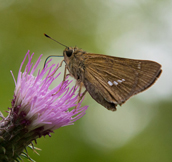
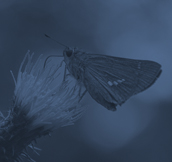 Parnara guttata (Straight Swift) Hesperiidae
Parnara guttata (Straight Swift) Hesperiidae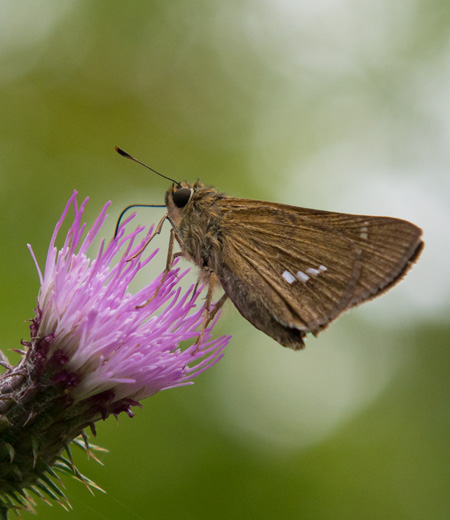 Main Region: Honshu, Shikoku, Kyushu and Nansei Islands.
Main Region: Honshu, Shikoku, Kyushu and Nansei Islands.
Found in forests and grasslands from flatlands to low elevations, and also at parks in cities.
With the body color, this species is often considered as moths.
(In reality, there is no clear distinction from butterflies and moths.)
Wing color on the front is brown and hind wings have distinct white dots creating one line, hence the Japanese name Ichimonji-seseri one straight line hesperiidae.
Is active during daytime and feed on nectar of flowers, and also on rotten fruits and dungs of animals.
Caterpillars feed on rice and green bristlegrass.
Tends to gather in groups, thus groups with large numbers of this species are seen sometimes.
●Wingspan about 35 to 40 mm
●Adult Flight Season May to about November -
Thoressa varia (Japanese Swift) Hesperiidae
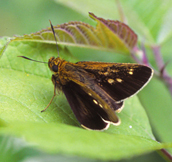
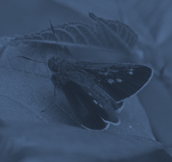 Thoressa varia (Japanese Swift) Hesperiidae
Thoressa varia (Japanese Swift) Hesperiidae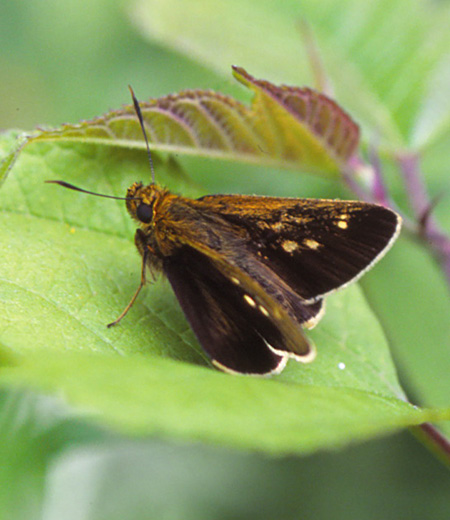 Main Region: Hokkaido, Honshu, Shikoku and Kyushu.
Main Region: Hokkaido, Honshu, Shikoku and Kyushu.
Found in forests and bushes from flatlands to mountains.
Often found in bamboo bushes with sasa veitchii and sasa nipponica as caterpillars feed on plants in sasa genus.
Wing color on the front is brown-black and yellow-brown closer to the body with some white spots.
On the back is yellow-brown with black lined wing veins and some whitish yellow spots.
Fly fast and straight in bamboo bushes and woods during daytime and feed on nectar of boneset and azalea, and also on dungs of animals.
Suck water in groups. Male holds territory.
●Wingspan about 30 to 36 mm
●Adult Flight Season May to about September -
Potanthus flavus (Japanese Dart) Hesperiidae
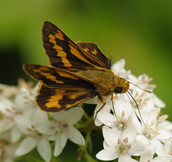
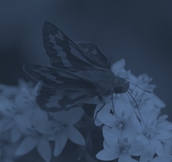 Potanthus flavus (Japanese Dart) Hesperiidae
Potanthus flavus (Japanese Dart) Hesperiidae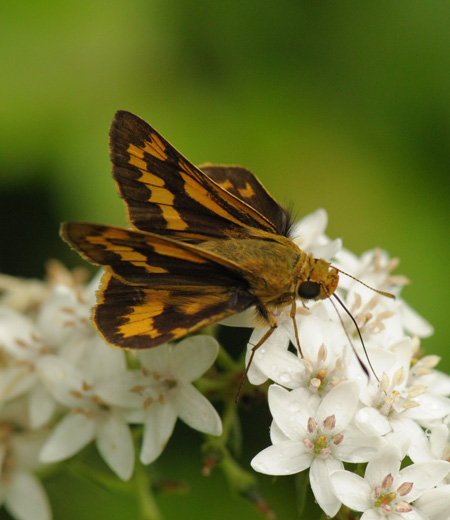 Main Region: South part of Hokkaido, Honshu, Shikoku, Kyushu, Tanega Island and Yaku Island.
Main Region: South part of Hokkaido, Honshu, Shikoku, Kyushu, Tanega Island and Yaku Island.
Found in sunny grasslands around forests from low elevations, hills and mountains.
Japanese name Kimadara-seseri literally meaning yellow irregularly patterned hesperiidae comes from its yellow irregularly placed pattern on brown wings.
Have similar patterns on both sides of wings but is yellow-brown on the back with less distinct patterns.
Adults fly from summer and feed on nectar of annual fleabane and Japanese thistle.
Suck water on the ground.
Caterpillars feed on leaves of poaceae family including Miscanthus sinensis, job's tears and Pleioblastus chino.
Tips of wings are sharp for male and round for female.
●Wingspan about 26 to 32 mm
●Adult Flight Season June to about September -
Ochlodes ochraceus Hesperiidae
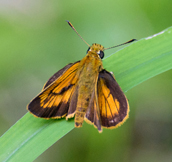
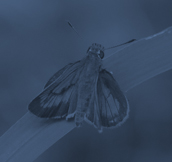 Ochlodes ochraceus Hesperiidae
Ochlodes ochraceus Hesperiidae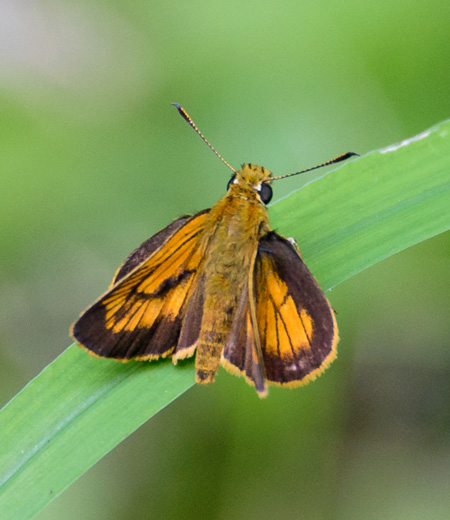 Main Region: Honshu, Shikoku and Kyushu.
Main Region: Honshu, Shikoku and Kyushu.
Found in forests, plateaus, forest trails from low elevations to mountains.
Japanese name Hime-kimadara-seseri literally meaning small yellow irregularly patterned hesperiidae (The Japanese Dart) but this species is about the same size with the Japanese Dart.
Wing color is reddish yellow with black-brown edges.
Patterns are rather net-like appearance not irregularly placed patterns that is distinguish them from the Japanese Dart.
Wings of female are dark brown with some yellow spots.
The back of wings for both male and female is orange to light yellow-brown and have stripe patterns along wing veins.
Fly fast closer to the ground in forests during daytime.
Feed on nectar of annual fleabane and azalea.
Caterpillars feed on leaves of poaceae family including Oplismenus undulatifolius and yamakamo-ashiboso(in Microstegium genus).
●Wingspan about 25 to 30 mm
●Adult Flight Season May to about September -
Daimio Tethys (China Flat) Hesperiidae
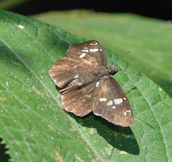
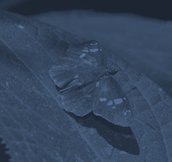 Daimio Tethys (China Flat) Hesperiidae
Daimio Tethys (China Flat) Hesperiidae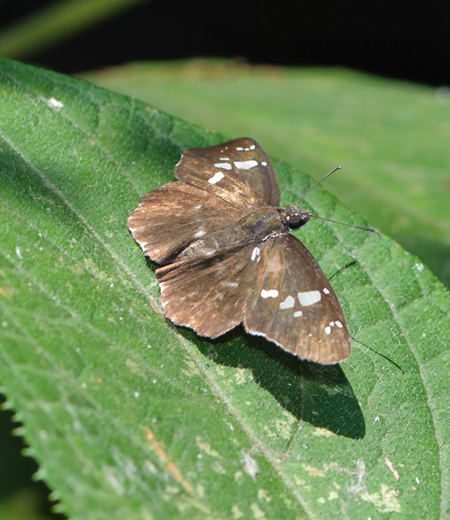 Main Region: Some parts of southern Hokkaido, Honshu, Shikoku and Kyushu.
Main Region: Some parts of southern Hokkaido, Honshu, Shikoku and Kyushu.
Found in forests from flatlands to low elevations.
Adults flight season is from spring to early autumn.
Fly fast and often seen in woody forests.
Fore wings are black-brown with three large white spots in the middle, and also some small white spots towards tips of wings.
These patterns vary depending on living areas.
Ones in west of Kinki region have white spots on the back of hind wings connecting to the patterns on fore wings creating belt-like patterns.
Feed on nectar of annual fleabane and azalea, also on dungs of animals and suck water.
Caterpillars feed on leaves of Japanese yam.
Male holds territory and shows strong territorial habit.
●Wingspan about 33 to 36 mm
●Adult Flight Season April to about October -
Erynnis montanus (Spring Flat) Hesperiidae
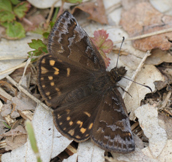
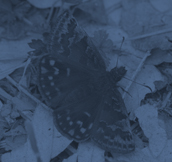 Erynnis montanus (Spring Flat) Hesperiidae
Erynnis montanus (Spring Flat) Hesperiidae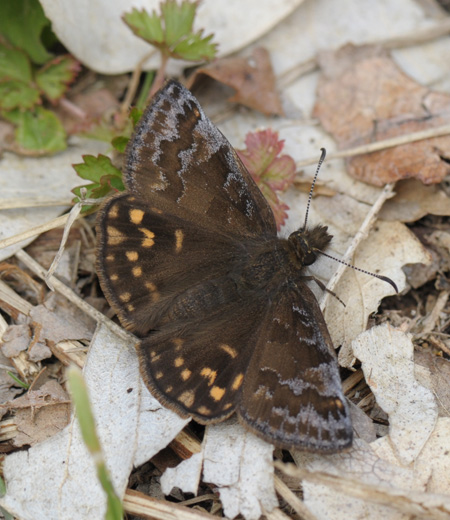 Main Region: Hokkaido, Honshu, Shikoku and Kyushu.
Main Region: Hokkaido, Honshu, Shikoku and Kyushu.
Found in sunny deciduous broad-leaved forests and open woods from flatlands to mountains.
Wing color is brown with complicated wavy patterns on fore wings that these patterns on male are purple-gray and on female are bright white belt-like patterns.
Both sides of hind wings have yellow spots.
Fly in forests during daytime and feed on flowers of azalea and dandelions.
Often rest on ground with wings opened for sun.
Adults flight season is short, from March to about April.
Caterpillars feed on leaves of quercus acutissima, quercus serrata and daimyo oak.
●Wingspan about 36 to 40 mm
●Adult Flight Season March to about April -
Isoteinon lamprospilus (The Silver-spotted Skipper) Hesperiidae
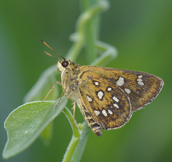
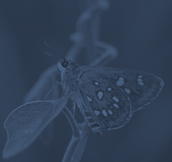 Isoteinon lamprospilus (The Silver-spotted Skipper) Hesperiidae
Isoteinon lamprospilus (The Silver-spotted Skipper) Hesperiidae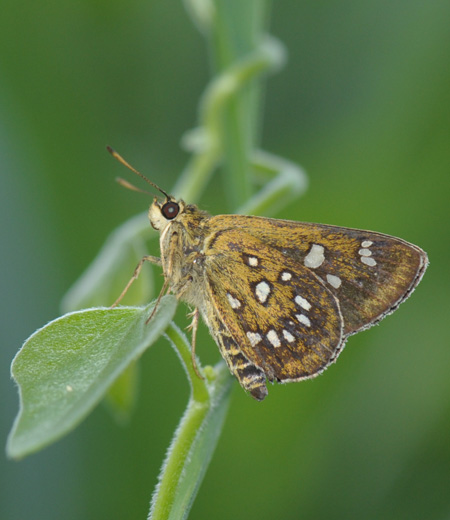 Main Region: Honshu (West of southern Tohoku region), Shikoku and Kyushu.
Main Region: Honshu (West of southern Tohoku region), Shikoku and Kyushu.
Found in forests and grasslands from flatlands to low elevations.
Wing color is black-brown and yellow-brown closer to the body.
The front of fore wings has some large white spots.
Wing color on the back is yellow-brown with white spots on black edges that are unique to this species.
Feed on nectar of Lysimachia clethroides and annual fleabane.
Suck water at where is some moisture.
Caterpillars feed on leaves of plants in poaceae family including spodiopogon sibiricus and miscanthus tinctorius hack.
Male holds territory over these plants in poaceae family.
●Wingspan about 32 to 37 mm
●Adult Flight Season June to about August -
Antheraea yamamai (Japanese Oak Silkmoth) Saturniidae
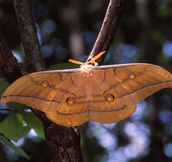
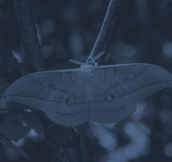 Antheraea yamamai (Japanese Oak Silkmoth) Saturniidae
Antheraea yamamai (Japanese Oak Silkmoth) Saturniidae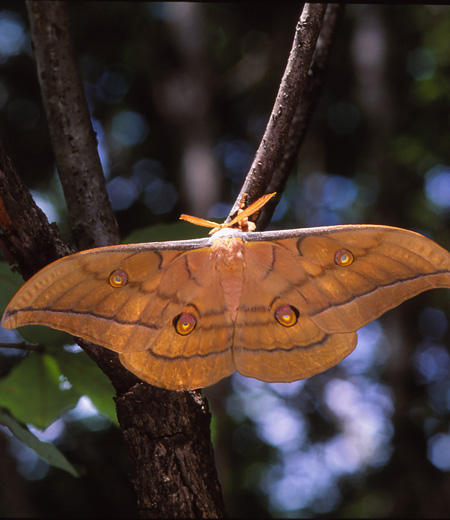 Main region: Hokkaido, Honshu, Shikoku, Kyushu, Tsushima and Yaku Island.
Main region: Hokkaido, Honshu, Shikoku, Kyushu, Tsushima and Yaku Island.
Found in woods and forests from flatlands to mountains.
The large species become up to 15 cm and it is the largest species in moths.
Are often found in mountains and used to reel silk off from cocoons of this species, hence the Japanese name Yama-mayu literally meaning mountain cocoons.
Wings are red-brown to ocher depends on individual species with long dark brown line along the edges.
Have eyespots in the center of wings.
Antennae differ from male and female, male is feathery and female is comb-like shaped.
Are active at night and often attracted to lights.
Adults do not feed on anything and live on nutrients reserved as caterpillars.
Caterpillars feed on quercus acutissima and quercus serrata.
Color of cocoons is similar to silkworm but this species are light green.
●Wingspan about 110 to 150 mm
●Adult Flight Season August to about September -
Saturnia jonasii Saturniidae
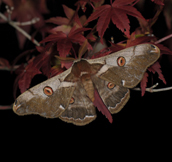
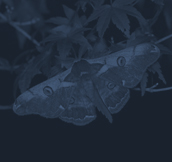 Saturnia jonasii Saturniidae
Saturnia jonasii Saturniidae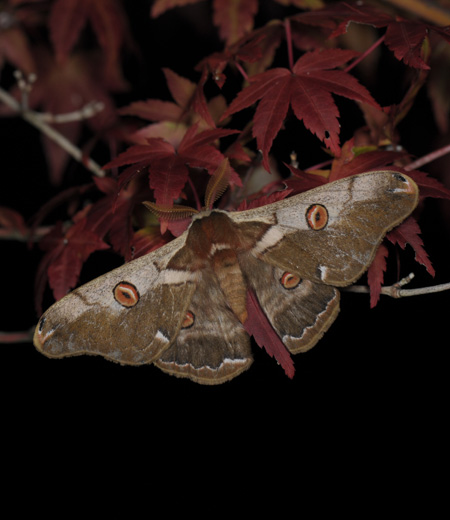 Main region: Hokkaido, Honshu, Shikoku, Kyushu, Tsushima and Yaku Island.
Main region: Hokkaido, Honshu, Shikoku, Kyushu, Tsushima and Yaku Island.
Found in forests and woods from flatlands to mountains.
Japanese name Hime-yamma-mayu literally meaning small Japanese oak silkmoth came from its body size smaller than Japaanese oak silkmoth.
Wing colors are smoky green and front part of fore wings is white.
Edges of wings are brown and each wing has large eyespots in the center.
Some species have red-brown edges and yellow-brown wing colors.
Are seen from later season than Japanese oak silkmoth and active at night.
Adults do not feed on anything like other species in saturniidae family.
Caterpillars feed on leaves of quercus acutissima, deutzia crenata and Japanese zelkova.
●Wingspan about 85 to 105 mm
●Adult Flight Season September to about November -
Saturnia japonica Saturniidae
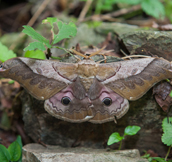
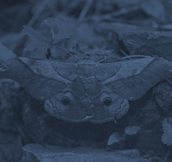 Saturnia japonica Saturniidae
Saturnia japonica Saturniidae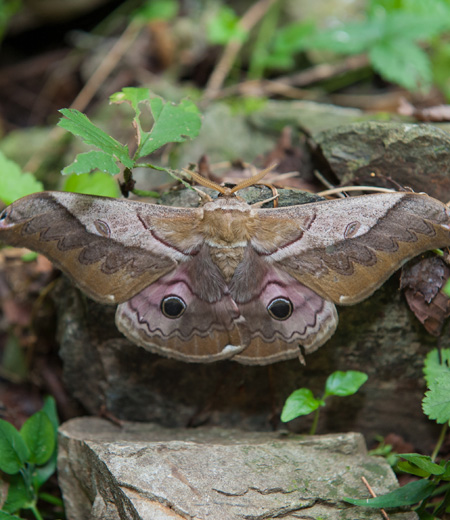 Main region: Hokkaido, Honshu, Shikoku, Kyushu, Tsushima and Yaku Island. Found in forests and woods from flatlands to mountains. Japanese name is Kusu-san literally meaning silkworm on camphor laurel. Body color varies to individuals among the same species from yellow-brown, red-brown to orange. Hind wings have distinct eyespots in the center and the ones on fore wings are not as distinct but have patterns resembling side face of lizard. Are attracted to lights at night with Japanese oak silkmoth and rest under the eaves nearby. Caterpillars are green with white long hair and are also known as Shiraga-taro literally meaning white haired boy. Feed on camphor laurel, Japanese zelkova and ginkgo. Cocoons are like mesh with and also called as Sukashi-tawara literally meaning sheer rice straw bag and the empty ones are often found in grasslands near forest trails.
Main region: Hokkaido, Honshu, Shikoku, Kyushu, Tsushima and Yaku Island. Found in forests and woods from flatlands to mountains. Japanese name is Kusu-san literally meaning silkworm on camphor laurel. Body color varies to individuals among the same species from yellow-brown, red-brown to orange. Hind wings have distinct eyespots in the center and the ones on fore wings are not as distinct but have patterns resembling side face of lizard. Are attracted to lights at night with Japanese oak silkmoth and rest under the eaves nearby. Caterpillars are green with white long hair and are also known as Shiraga-taro literally meaning white haired boy. Feed on camphor laurel, Japanese zelkova and ginkgo. Cocoons are like mesh with and also called as Sukashi-tawara literally meaning sheer rice straw bag and the empty ones are often found in grasslands near forest trails.
●Wingspan about 100 to 120 mm
●Adults Flight Season August to about October -
Actias artemis Saturniidae
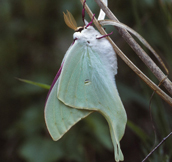
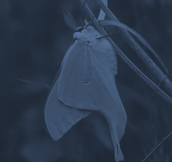 Actias artemis Saturniidae
Actias artemis Saturniidae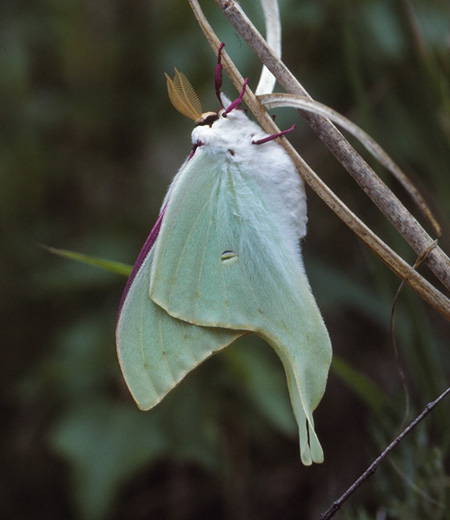 Main region: Hokkaido, Honshu, Shikoku, Kyushu, Tsushima and Yaku Island.
Main region: Hokkaido, Honshu, Shikoku, Kyushu, Tsushima and Yaku Island.
Found in forests and plateaus from flatlands to mountains.
Wing colors is blue-white to light green with front part of fore wing edges are red.
Have small eyespots on both fore and hind wings.
Antennae are feathery for male and comb-like shaped for female.
Tails are longer for male than female.
Adults flight season are twice per year, early summer and mid summer from July to August.
Are often attracted to lights.
Mouthparts of adults are degenerated in the imago and do not eat anything and only live on nutrients reserved as caterpillars.
Caterpillars feed on leaves of trees including quercus serrata, ume (Japanese apricot), apricot, fig, pear and apple.
●Wingspan about 80 to 120 mm
●Adult Flight Season April to about May, July to about August -
Catocala nivea Noctuidae
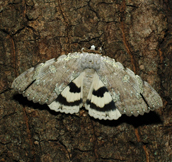
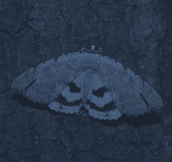 Catocala nivea Noctuidae
Catocala nivea Noctuidae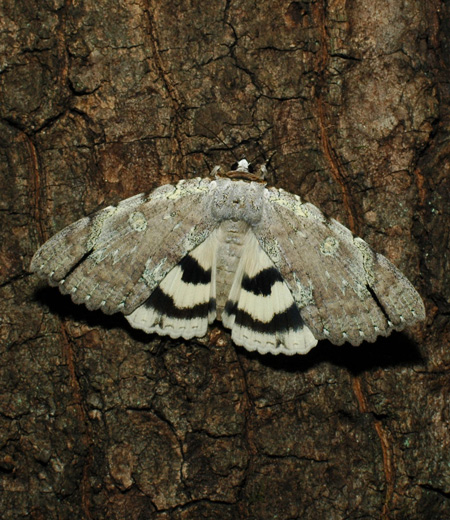 Main region: Hokkaido, Honshu, Shikoku and Kyushu.
Main region: Hokkaido, Honshu, Shikoku and Kyushu.
Found in forests and green spaces from low elevations to mountains.
Fore wings is gray-brown with shaded patterns resembling barks and hind wings is white with two black belt-like patterns.
Hind wings are hidden behind fore wings and fore wings mimic barks so it is difficult to find when resting on barks.
When receiving any stimulus from something, open fore wings to show hind wings that are said to threat enemies.
During daytime, are often rest on trunks and branches of trees.
Become active at night and fly to various trees for sap.
Caterpillars feed on leaves of plants in rosaceae family including Japanese bird cherry.
●Wingspan about 80 to 95 mm
●Adult Flight Season July to about October -
Biston robustus Geometridae

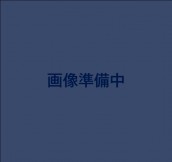 Biston robustus Geometridae
Biston robustus Geometridae Main region: Hokkaido, Honshu, Shikoku, Kyushu, Izu Islands, Tsushima and Nansei Islands.
Main region: Hokkaido, Honshu, Shikoku, Kyushu, Izu Islands, Tsushima and Nansei Islands.
Found in woods and green spaces from flatlands to low elevations.
Wing colors is gray to brown like with bark-like patterns that is difficult to find when resting on trees. There are a lot of moths like these patterns but some could be recognized with paired patterns and unnatural depth on trees.
This species are large in geometridae family and seen from March to April.
Male are often attracted to lights.
Caterpillars are inchworms resembling tree branches and feed on leaves of various kinds of plants including apple, pairs, camellia, Japanese chestnuts, quercus acutissima and quercus serrata.
●Wingspan about 40 to 75 mm
●Adult Flight Season May to about April -
Erannis golda Geometridae
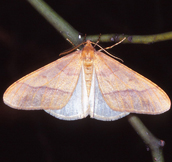
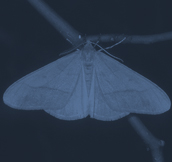 Erannis golda Geometridae
Erannis golda Geometridae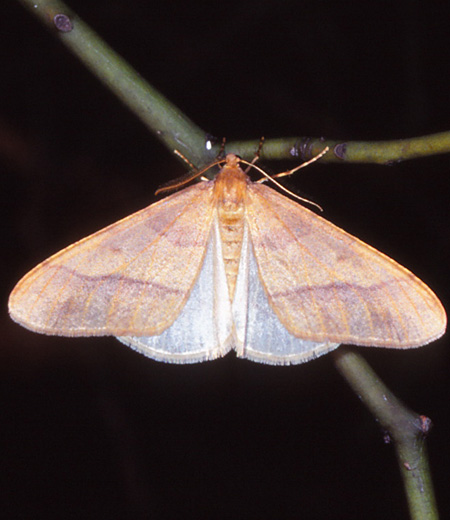 Main region: Hokkaido, Honshu, Shikoku, Kyushu and Okinawa.
Main region: Hokkaido, Honshu, Shikoku, Kyushu and Okinawa.
Found in woods and surrounding green spaces from flatlands to mountains.
One of few species active during winter and adults flight season is from late autumn to midwinter, January.
Fore wings are brown to yellow-brown with dark belt-like patterns as Japanese name Cha-bane-fuyu-eda-shaku literally meaning brown wings winter branches Geometridae states.
Similar erannis defoliaria gigantea inoue can be distinguished by this belt-like patterns are widely curved. Hind wings are lighter brown than fore wings.
Female body length is 11 to 15 cm without wings and only walk with long and strong legs.
Body shape is similar to caterpillars of shield bugs and body color is white with black spots.
Caterpillars feed on leaves of various plants including quercus serrata, poplar, willow, rose and azalea.
●Wingspan about 34 to 45 mm
●Adult Flight Season November to about January -
Ourapteryx nivea Geometridae
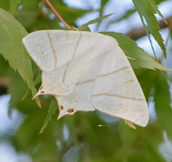
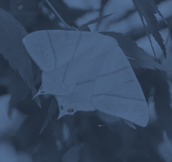 Ourapteryx nivea Geometridae
Ourapteryx nivea Geometridae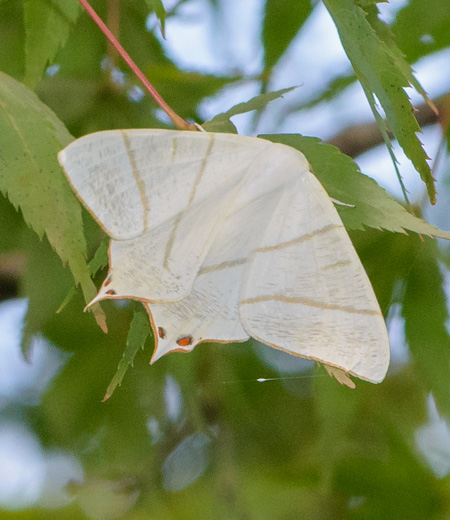 Main region: Hokkaido, Honshu, Shikoku, Kyushu and Nansei Islands.
Main region: Hokkaido, Honshu, Shikoku, Kyushu and Nansei Islands.
Found in all over Japan, in forests and surrounding grasslands from flatlands to mountains.
In Mt. Takao, often found on leaves in mountain trails. Wing color is white.
Fore wings have two brown belt-like patterns with fine scratchy patterns.
Similar ourapteryx maculicaudaria can be distinguished by not having these scratchy patterns and looks rather white.
Have sharp tails with two red-brown spots.
Female are larger than male.
Are seen from early summer to autumn and fly to various flowers for nectar.
Caterpillars feed on leaves of various plants in fagaceae, ulmaceae, fabaceae and caprifoliaceae family.
●Wingspan about 36 to 59 mm
●Adult Flight Season May to about October -
Trichodezia kindermanni leechi Geometridae

 Trichodezia kindermanni leechi Geometridae
Trichodezia kindermanni leechi Geometridae Main region: Hokkaido, Honshu, Shikoku, Kyushu and Mikura Island.
Main region: Hokkaido, Honshu, Shikoku, Kyushu and Mikura Island.
Found in forests, green spaces and forest trails along streamside from flatlands to mountains.
Wingspan is less than 3 cm and often found in wet and shady area or grassland near waterside.
Wing color is black with white belt-like patterns in the center.
Some species have white spots and linear patterns at edges and base of wings.
Are active during daytime and often mistaken by butterfly as they fly by flattering wings.
Adults flight season are twice, early summer and midsummer and often visit various flowers for nectar.
Caterpillars eat leaves of hydrangea serrata.
●Wingspan about 20 to 26 mm
●Adult Flight Season May, July to about August -
Amata fortunei Arctiidae
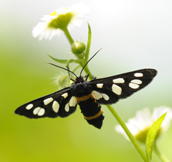
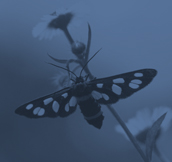 Amata fortunei Arctiidae
Amata fortunei Arctiidae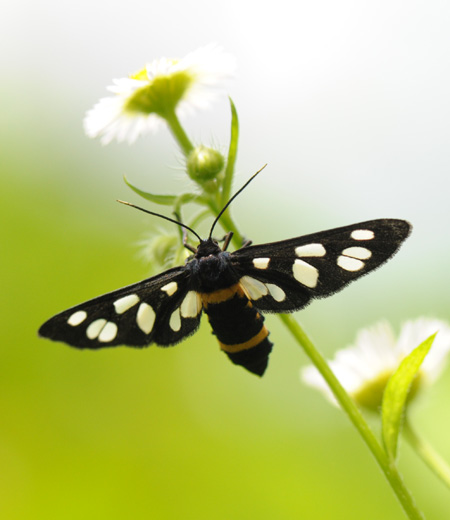 Main region: Hokkaido, Honshu, Shikoku, Kyushu and Tsushima.
Main region: Hokkaido, Honshu, Shikoku, Kyushu and Tsushima.
Found in woods, green space and open fields from flatlands to low elevations.
Wing color is black with some transparent spots resembling babies of Japanese deers, hence the Japanese name Kanoko-ga literally meaning Japanese deer baby moths.
Wings are elongated and body colors are black with yellow belt-like patterns resembling bees.
Female have thicker abdomen than male.
Are seen from early summer to early autumn.
Are active during daytime and feed on nectar of various flowers.
Caterpillars are black hairy worms and feed on various plants in riverbeds and grasslands including white clovers, dandelions and rumex japonicus.
●Wingspan about 30 to 37 mm
●Adult Flight Season June to about September -
Thyris usitata Thyrididae
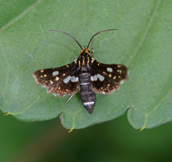
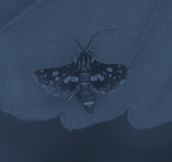 Thyris usitata Thyrididae
Thyris usitata Thyrididae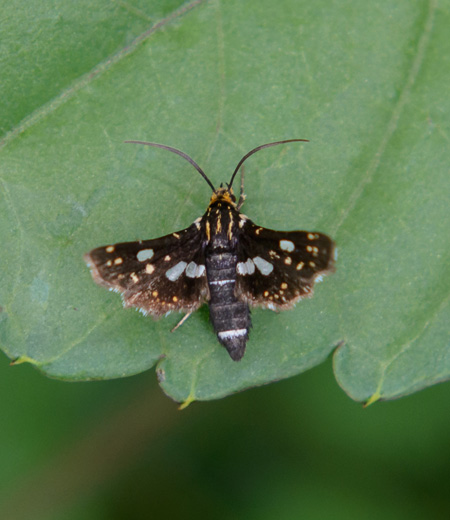 Main region: Hokkaido, Honshu, Shikoku, Kyushu, Sado Island, Tsushima and Chishima Islands.
Main region: Hokkaido, Honshu, Shikoku, Kyushu, Sado Island, Tsushima and Chishima Islands.
Found in woods and surrounding grasslands and fields from flatlands to mountains.
Wing colors are black and angulated white spots are one paired on fore wings and two paired on hind wings, hence the Japanese name Mado-ga literally meaning window moths.
Have some yellow spots on entire wings.
Head and the back of thorax are yellow and resemble butterflies in hesperiidae family.
Are seen from early spring to summer.
In Mt. Takao, often found on mountain trails and grasslands along forest trails.
Are active during daytime and fly to forests and grasslands for nectar.
Caterpillars feed on leaves of clematis apiifolia.
●Wingspan about 14 to 17 mm
●Adult Flight Season April to about September -
Nemophora aurifera Adelidae
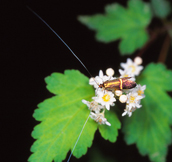
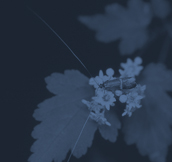 Nemophora aurifera Adelidae
Nemophora aurifera Adelidae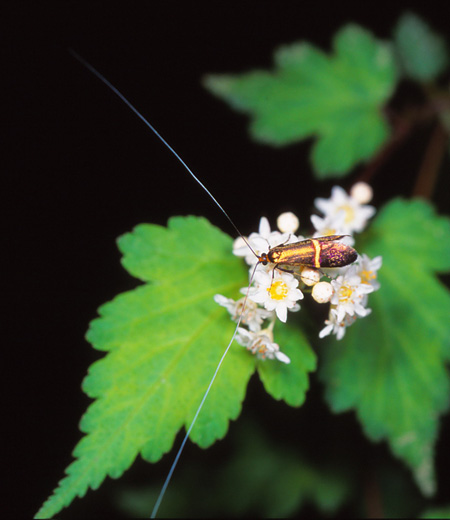 Main region: Hokkaido, Honshu, Shikoku, Kyushu, Sado Island and Tsushima.
Main region: Hokkaido, Honshu, Shikoku, Kyushu, Sado Island and Tsushima.
Found in woods and green spaces from flatlands to mountains.
Wing color is metallic and shiny and differs from gold to red-copper by reflection of light.
Do not look like moths with golden belt-like patterns run horizontally at the bottom of fore wings.
Japanese name Hoso-obi-hige-naga literally meaning thin belt with long antennae was named because of their long antennae and its lengths for male are triple the body length and 1.2 times longer for female.
Half part of antennae is feathery and black.
Are seen from early summer and active during daytime and feed on nectar.
Often found even in nearby fields or grasslands.
Male flies in groups within forests.
●Wingspan about 15 to 22 mm
●Adult Flight Season April to about May -
Epicopeia hainesii Epicopeiidae
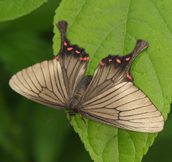
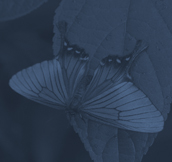 Epicopeia hainesii Epicopeiidae
Epicopeia hainesii Epicopeiidae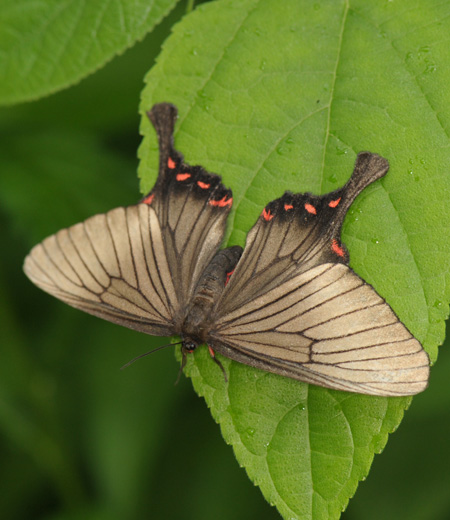 Main region: Hokkaido, Honshu, Shikoku, Kyushu and Tsushima.
Main region: Hokkaido, Honshu, Shikoku, Kyushu and Tsushima.
Found in forests and grasslands from flatlands to mountains.
Are parts of moth family but body mimic Chinese windmill that is toxic by eating poisonous plants, hence the Japanese name Ageha-modoki literally meaning swallowtail mimic.
Wing veins are distinctive black and gray-black wings are almost like Chinese windmill with big long tails but red spots on edges of hind wings are brighter and body size is a lot smaller.
Are active from late afternoon and attracted to lights but found on leaves even during daytime.
Fly by flattering wings to fields and woods for nectar.
The body of caterpillars are covered with white cotton-like covering and feed on leaves of kouza dogwood and giant dogwood.
●Wingspan about 55 to 60 mm
●Adult Flight Season May to about August -
Psychostrophia melanargia Epicopeiidae
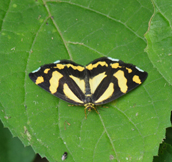
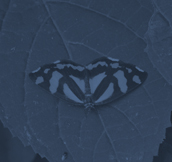 Psychostrophia melanargia Epicopeiidae
Psychostrophia melanargia Epicopeiidae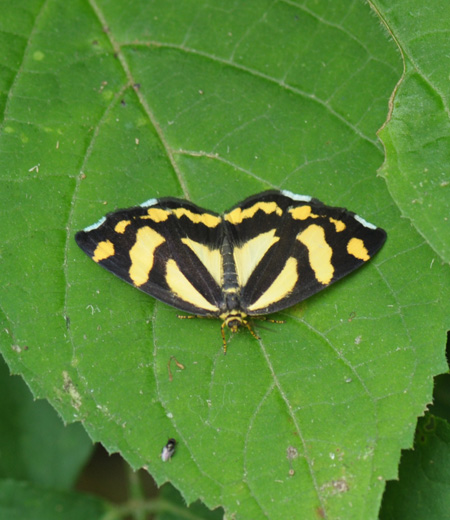 Main region: Honshu, Shikoku and Kyushu.
Main region: Honshu, Shikoku and Kyushu.
Found in woods and green spaces from flatlands to mountains.
Also often found at parks in forests and even in cities.
Wing color is black with many light yellow spots.
With its body color and are active during daytime, are often mistaken as butterflies.
The size of patterns differs by each species.
Adults flight season is from May to June and from August to September.
Fly to various flowers for nectar.
Caterpillars feed on leaves of clethra barbinervis.
The body of caterpillars is covered with white powdery covering and this powdery covering is also applied to cocoons.
●Wingspan about 32 to 39 mm
●Adult Flight Season May to about June, August to about September -
Cicindela chinensis(Tiger Beetle) Cicindelidae
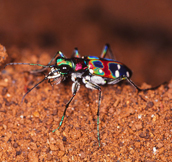
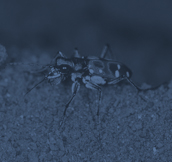 Cicindela chinensis(Tiger Beetle) Cicindelidae
Cicindela chinensis(Tiger Beetle) Cicindelidae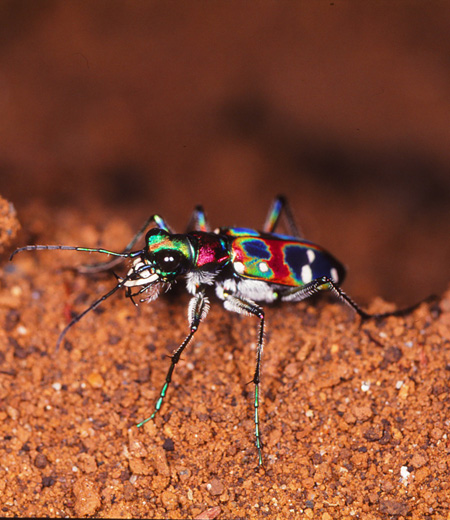 Main Region: Honshu, Shikoku, Kyushu, Tsushima and Yaku Island.
Main Region: Honshu, Shikoku, Kyushu, Tsushima and Yaku Island.
Found in sunny woods and forest trails along streams from flatlands to mountains.
Body color is metallic shiny blue-green with bright red and are known as beautiful insects like jewel beetles.
Have large compound eyes with large mandibles.
Feed on insects.
Aim at insects and catch immediately are just like cats, hence the Japanese name han-myo literally meaning spots-cats.
When human being approaches and they fly to a couple of meters ahead, this behavior is repeated and like guiding human beings, hence they are also called michi-oshie literally meaning guiding ways.
Larvae create holes on ground and catch insects like ants that approaches to these holes.
●Length about 18 to 20 mm
●Adults Flight Season April to about September -
Damaster blaptoides Carabidae
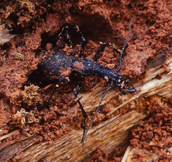
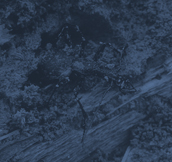 Damaster blaptoides Carabidae
Damaster blaptoides Carabidae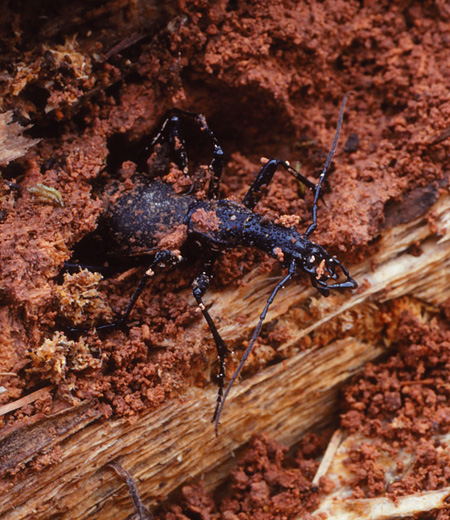 Main Region: Hokkaido, Honshu, Shikoku, Kyushu, Goto Islands, Yaku Island and Tanega Island. Found in forests from flatlands to mountains and wet grasslands. Is a part of carabidae family and inhabits only in Japan. Both adults and larvae feed on snails and sticking the head in snail's shells when they eat, hence the Japanese name Maimai-kaburi literally meaning wearing snails. Cannot fly as their wings are deteriorated and do not travel long distance, thus their body color and body shape varies by their living area. Normally categorized to various subspecies by habitat. The ones seen in Mt. Takao are the subspecies called D.b.oxuroides Schaum and have bluish black body color.
Main Region: Hokkaido, Honshu, Shikoku, Kyushu, Goto Islands, Yaku Island and Tanega Island. Found in forests from flatlands to mountains and wet grasslands. Is a part of carabidae family and inhabits only in Japan. Both adults and larvae feed on snails and sticking the head in snail's shells when they eat, hence the Japanese name Maimai-kaburi literally meaning wearing snails. Cannot fly as their wings are deteriorated and do not travel long distance, thus their body color and body shape varies by their living area. Normally categorized to various subspecies by habitat. The ones seen in Mt. Takao are the subspecies called D.b.oxuroides Schaum and have bluish black body color.
●Length about 36 to 41 mm(Carabus blaptoides oxuroides)
●Adults Flights Season April to about October -
Carabus insulicola Carabidae
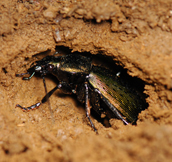
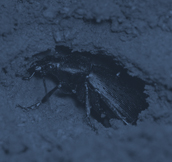 Carabus insulicola Carabidae
Carabus insulicola Carabidae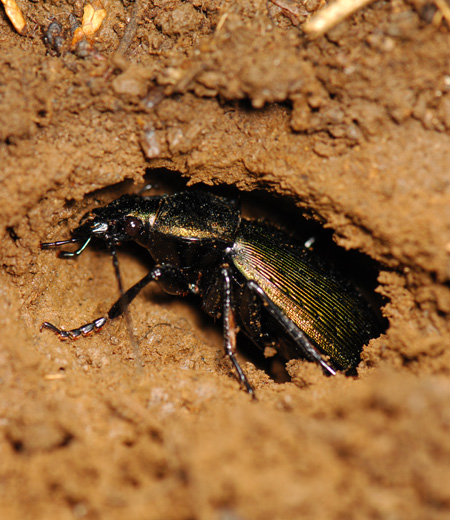 Main Region: Honshu (North of Chubu area).
Main Region: Honshu (North of Chubu area).
Found in woods and green space from flatlands to mountains.
This species of carabidae family are most frequently seen in Kanto region.
Body color is beautiful metallic green and some species are red-copper color.
Have some fine stripes on fore wings.
Cannot fly with deteriorated hind wings just like other species in carabidae family.
Does not prefer sunny places and mostly stay under fallen leaves, in soils and under fallen woods.
Active at night, walk around and feed on larvae of earthworms and moths and woodlouse.
Also often gather around dead small animals.
Larvae are also predatory and feed on small insects.
●Length about 25 to 30 mm
●Adults Flight Season April to about October -
Carabus albrechti esakianus Carabidae
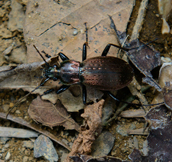
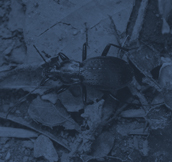 Carabus albrechti esakianus Carabidae
Carabus albrechti esakianus Carabidae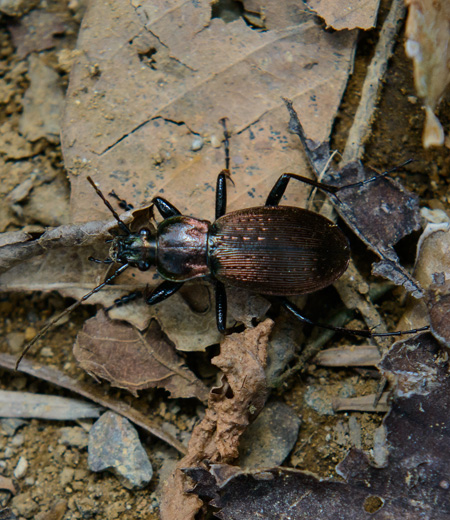 Are subspecies of carabus albrechti Morawitz found from Hokkaido to middle of Honshu and distributed from Kanto region to Niigata prefecture. They are same species but categorized as different group by region. The species in carabidae family are often seen around Tokyo area like carabus insulicola. Found in woods and surrounding green spaces from flatlands to mountains. Body color is metallic shine red-copper but some species are without shines. Fore sings have fine stripes and cannot fly with deteriorated hind wings. During daytime, hide under woods and fallen leaves or are active in shady area. Become active at night, walk around and feed on small insects, woodlouse and earthworm.
Are subspecies of carabus albrechti Morawitz found from Hokkaido to middle of Honshu and distributed from Kanto region to Niigata prefecture. They are same species but categorized as different group by region. The species in carabidae family are often seen around Tokyo area like carabus insulicola. Found in woods and surrounding green spaces from flatlands to mountains. Body color is metallic shine red-copper but some species are without shines. Fore sings have fine stripes and cannot fly with deteriorated hind wings. During daytime, hide under woods and fallen leaves or are active in shady area. Become active at night, walk around and feed on small insects, woodlouse and earthworm.
●Length about 20 to 23 mm
●Adults Flight Season April to about October -
Chlaenius micans Carabidae
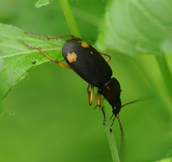
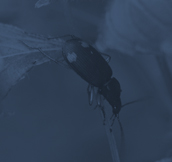 Chlaenius micans Carabidae
Chlaenius micans Carabidae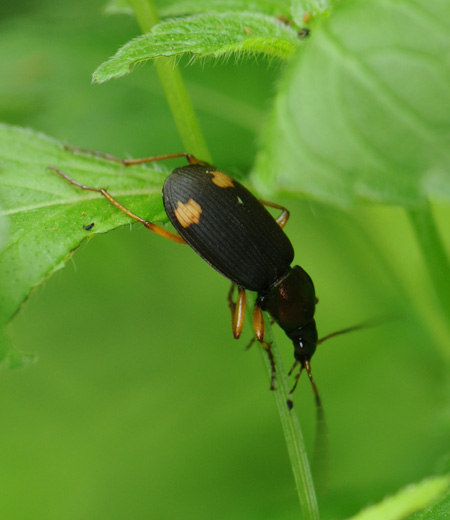 Main Region: Hokkaido, Honshu, Shikoku, Kyushu, Okinawa, Miyako Island and Ishigaki Island.
Main Region: Hokkaido, Honshu, Shikoku, Kyushu, Okinawa, Miyako Island and Ishigaki Island.
Found in woods and surrounding green spaces from flatlands to low elevations and also in croplands and riverbeds.
Have yellow-brown paired spots on the bottom of fore wings as the Japanese name Oo-ato-boshi-aogomimushi literally meaning large back stars carabidae states.
Head and thorax are shiny blue-green and fore wings are copperish.
Golden hair is covered on the back so the shiny texture on body is not visible.
During daytime, walk around and feed on small insects including larvae of moths and flies and dead animals. Larvae feed on the same with adults.
Are attracted to lights.
●Length about 15 to 18 mm
●Adults Flight Season May to about October -
Macrodorcus rectus Lucanidae
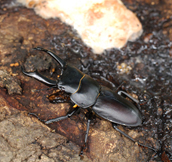
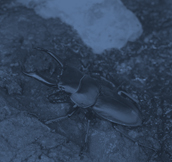 Macrodorcus rectus Lucanidae
Macrodorcus rectus Lucanidae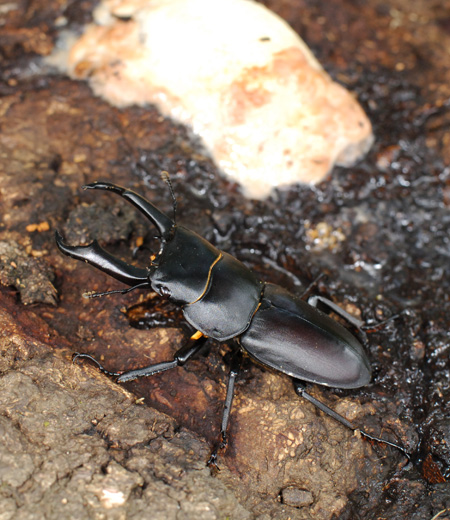 Main region: Hokkaido, Honshu, Shikoku, Kyushu, Izu Islands, Sado Island, Tsushima and Yaku Island.
Main region: Hokkaido, Honshu, Shikoku, Kyushu, Izu Islands, Sado Island, Tsushima and Yaku Island.
Found in mountainous forests or woodlands.
Often seen in Takao from early summer to autumn.
Has small body but some big adults have outstanding mandibles.
Are less active during daytime and likely to hide in hollow of trees or space at tree base and become more active after sunset.
Fly to quercus serrata or quercus acutissima for sap.
Able to hide and suck sap in hollow space under the bark of tree where large lucanidae cannot go into.
●Length (including mandible) about 20 to 55 mm
●Adult Flight Season June to about September -
Dorcus striatipennis Lucanidae
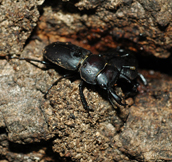
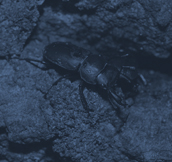 Dorcus striatipennis Lucanidae
Dorcus striatipennis Lucanidae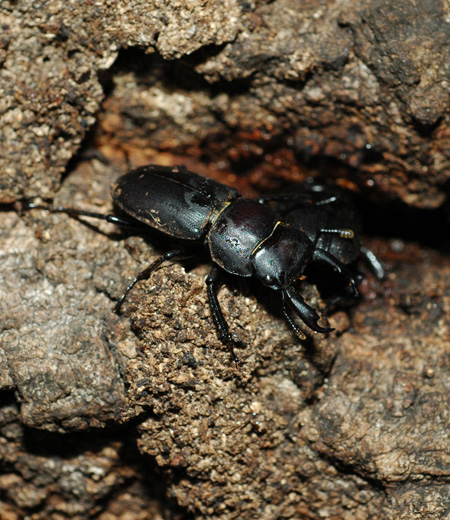 Main region: Hokkaido, Honshu, Shikoku and Kyushu.
Main region: Hokkaido, Honshu, Shikoku and Kyushu.
Found in forests and woodlands from low to high elevations.
Japanese name Sujikuwagata literally meaning stripes lucanidae and small male and female have stripes patterns on upper wing like wood grains.
Large ones does not have these linear patterns and similar to male dorcus rectus.
Only difference is protrusions inside of mandibles, triangle for dorcus rectus and square for dorcus striatipennis.
Main foods are sap from quercus acutissima, quercus serrata and basket willow.
Often gather to lights.
Larva grows inside of decaying logs of quercus acutissima and quercus serrata.
●Length about 15 to 30 mm
●Adult Flight Season June to about September -
Prosopocoilus inclinatus Lucanidae
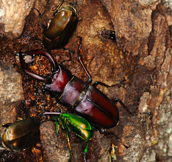
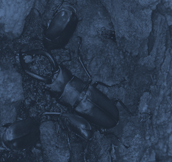 Prosopocoilus inclinatus Lucanidae
Prosopocoilus inclinatus Lucanidae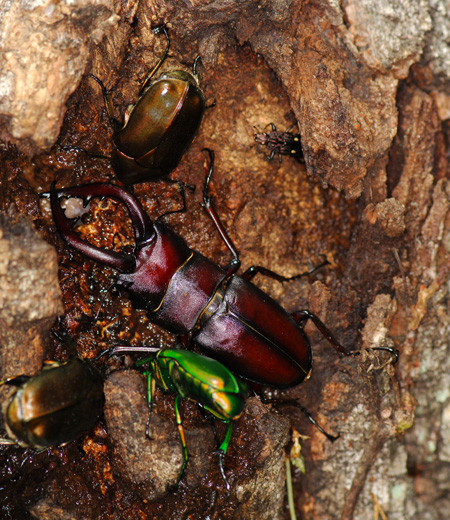 Main region: Hokkaido, Honshu, Shikoku, Kyushu, Sado Island, Tsushima and Yaku Island.
Main region: Hokkaido, Honshu, Shikoku, Kyushu, Sado Island, Tsushima and Yaku Island.
Found in woodland in low elevation.
Are very popular among children and have dark brow to red brown body with elongated curved mandibles.
Sometimes small males only have small mandibles.
Rest on the upper part of trees during the daytime but become active at night and fly to quercus acutissimam, basket willow and quercus serrata for sap, their main food.
Most of them die after summer like lucanidae but some do make it through the winter.
●Length about 25 to 75 mm
●Adult Flight Season June to about August -
Lucanus maculifemoratus Lucanidae
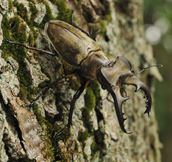
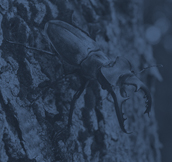 Lucanus maculifemoratus Lucanidae
Lucanus maculifemoratus Lucanidae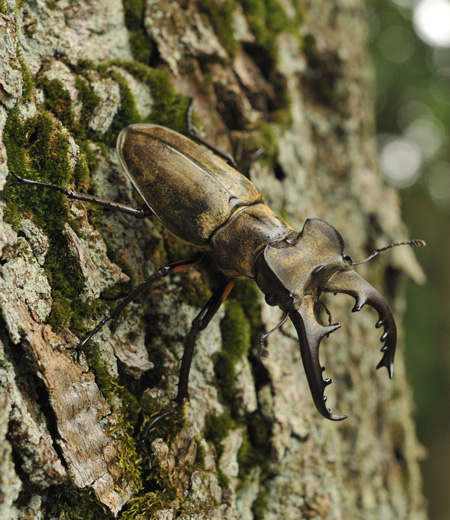 Main region: Hokkaido, Honshu, Shikoku, Kyushu, Sado Island and Iki Island.
Main region: Hokkaido, Honshu, Shikoku, Kyushu, Sado Island and Iki Island.
Found in woodland and beechwood forests.
Are popular for their masculine body but limited habitat compare to dorcus rectus and prosopocoilus inclinatus. The protrusions are from the back of their head that is unique to this species.
They grow with age like mandibles and rarely seen on small species.
Male body is brownish black to brownish red with gold hair on body surface.
Female body is brownish black.
They are more active at night than daytime, fly to quercus acutissimam and quercus serrata for sap.
●Length about 30 to 80 mm
●Adult Flight Season July to about August -
Trypoxylus dichotomus (Japanese Rhinoceros Beetle) Scarabaeidae
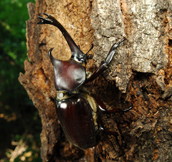
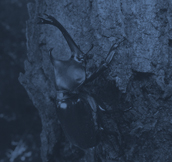 Trypoxylus dichotomus (Japanese Rhinoceros Beetle) Scarabaeidae
Trypoxylus dichotomus (Japanese Rhinoceros Beetle) Scarabaeidae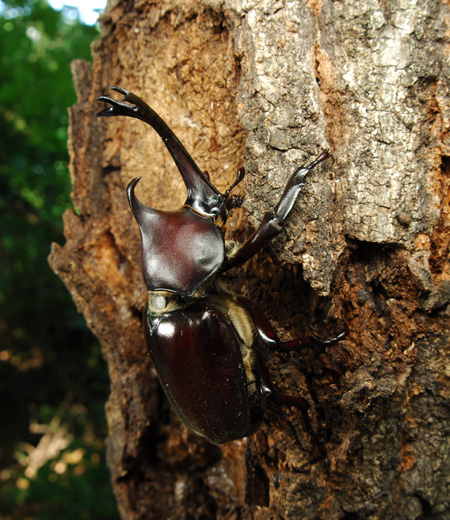 Main region: Honshu, Shikoku and Kyushu.
Main region: Honshu, Shikoku and Kyushu.
Male have big and brave horn and are called as the king of insects in Japan and has been very popular among children but they are also found in the Korean Penninsula, China and north of Indochina Peninsula.
Found in forests and woodlands from flatland to mountains and fly to fly to quercus acutissimam and quercus serrata for sap.
Have sharp claws at the tips of legs that enable them to hold their bodies to vertically grown tree.
With their horn and big bodies, do not allow other insects gather for sap of tree.
Lay eggs in soil and emerge to adults on the following year and live only for two to three months.
●Length (including horn) about 30 to 50 mm
●Season June to about August -
Rhomborrhina japonica Scarabaeidae
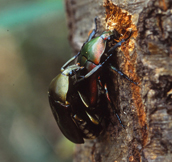
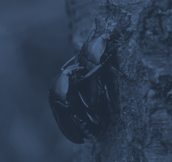 Rhomborrhina japonica Scarabaeidae
Rhomborrhina japonica Scarabaeidae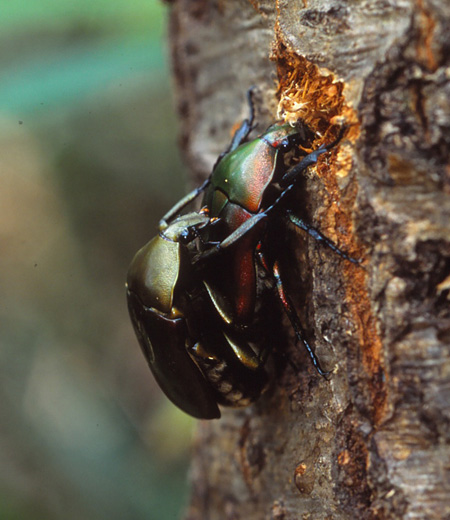 Distributed in Honshu, Shikoku, Kyushu, and Sado Island, Izu Islands, GotoIslands, Yaku Island, etc.
Distributed in Honshu, Shikoku, Kyushu, and Sado Island, Izu Islands, GotoIslands, Yaku Island, etc.
It is found mainly in lowland thickets and forests.
In Mt. Takao, it can often be seen on mountain roads and forestpaths.
It is also common in urban areas where there are parks and roadside
trees.
It is characterized by its flattened body shape and square head.
The body color varies considerably from copper to almost green, but all have a distinctive glow that makes them extremely beautiful.
It prefers tree sap from sawtooth oak, konara oak, and willow trees, and congregates in these trees during the daytime.
They have high flight ability and do not open their upper wings (the hard wings that cover the back of the beetle) but only spread their hind wings (the soft wings that are folded under the upper wings of the beetle).
●Length about 22 to 30 mm
●Adult Flight Season July to August -
Rhomborrhina unicolor Scarabaeidae
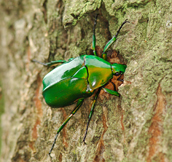
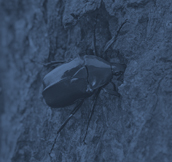 Rhomborrhina unicolor Scarabaeidae
Rhomborrhina unicolor Scarabaeidae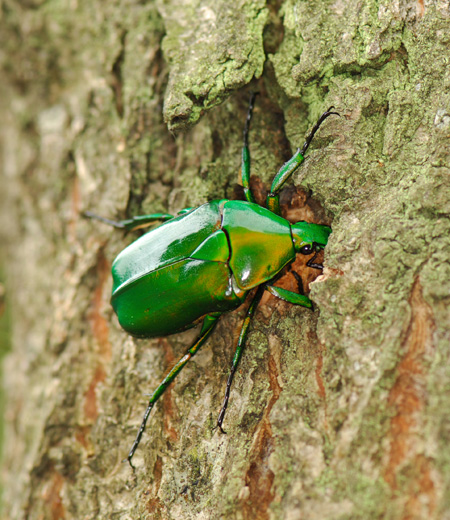 Main region: Honshu, Shikoku, Kyushu, Sado Island, Tanega Island and Yaku Island.
Main region: Honshu, Shikoku, Kyushu, Sado Island, Tanega Island and Yaku Island.
Found in woodland or forests from low elevation to mountains.
Suck sap of quercus acutissimam, quercus serrata and basket willow.
During short summer from July to August, seen on these trees with stag beetles, beetles and bees for sap.
Body size and biology is quite similar to rhomborrhina japonica.
Body color of rhomborrhina japonica varies from copper to green but that of this species is deep metallic green.
There is also a species called rhomborrhina polita which body color is black.
This species and rhomborrhina polita are rarely found in city area.
●Length about 22 to 30 mm
●Adult Flight Season July to about August -
Paratrichius doenitzi Scarabaeidae
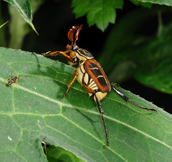
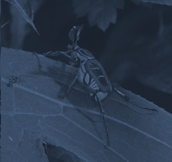 Paratrichius doenitzi Scarabaeidae
Paratrichius doenitzi Scarabaeidae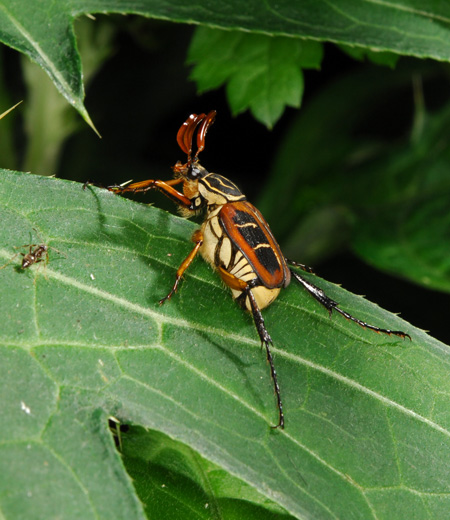 Main region: Honshu.
Main region: Honshu.
Found in green area or grassland from low elevation to mountains.
Is a kind of cetonia that can only be seen from early summer to summer.
Is popular among fans of insects for the large colorful patterns on its back.
This pattern is seen only on male and female has white pattern on their black body and a lot different from males.
Their antennas are spread in three.
Seen on leaves or flowers on grass on mountain trails.
Fly various places and flowers and eat pollen.
Larva eats rotten wood.
●Length about 12 to 16 mm
●Adult Flight Season June to about August -
Popillia japonica Scarabaeidae
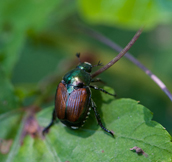
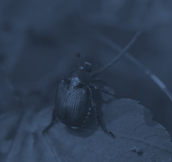 Popillia japonica Scarabaeidae
Popillia japonica Scarabaeidae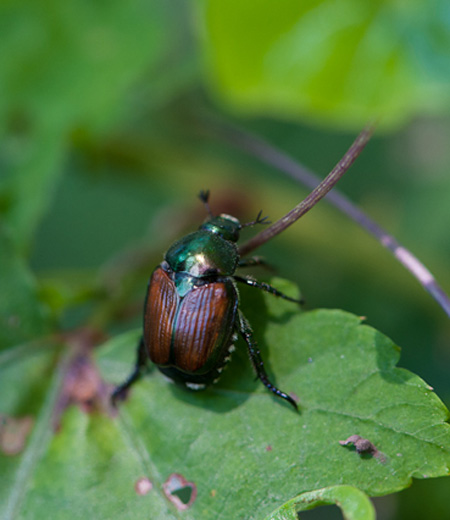 Main region: Hokkaido, Honshu, Shikoku, Kyushu, Tsushima and Yaku Island.
Main region: Hokkaido, Honshu, Shikoku, Kyushu, Tsushima and Yaku Island.
Found in green space or grassland from flatland to mountains.
Larva eats various kinds of plants in soils and sometimes roots of fabaceae family.
Adults are known as destructive insects because eat sprout, leaves and flowers of the plants, so they are often found in farmland rather than in natural environment.
Sometimes they grow in large numbers to cause damage to cultivations.
Body length is small and about 1cm.
Body color from head to abdomen is shiny deep green and its front wing surface has shiny red brown color and is quite beautiful.
Appear from the early summer and tends to gather to food plants during the daytime.
●Length about 9 to 13 mm
●Adult Flight Season May to about August -
Phelotrupes laevistriatus Scarabaeidae
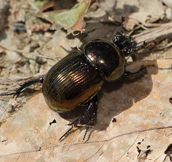
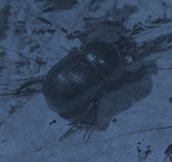 Phelotrupes laevistriatus Scarabaeidae
Phelotrupes laevistriatus Scarabaeidae Main region: Hokkaido, Honshu, Shikoku, Kyushu, Tsushima and Yaku Island.
Main region: Hokkaido, Honshu, Shikoku, Kyushu, Tsushima and Yaku Island.
Found in green area or forests from flatland to mountains as well as cropland and residential area.
Body color is mostly metallic black and sometimes purplish, indigo or greenish black and they are quite beautiful.
They are so-called dung beetles and their main foods are dungs from animals and seek them while flying close to the ground with beating its wings or walking on grounds.
Female bring dungs in soils and lay eggs in soils sealed with dungs and larva can eat them to grow.
In Takao, easily be found on mountain trails.
●Length about 14 to 20 mm
●Adult Flight Season April to about November -
Lyponia quadricollis Lycidae
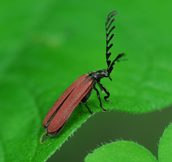
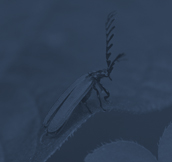 Lyponia quadricollis Lycidae
Lyponia quadricollis Lycidae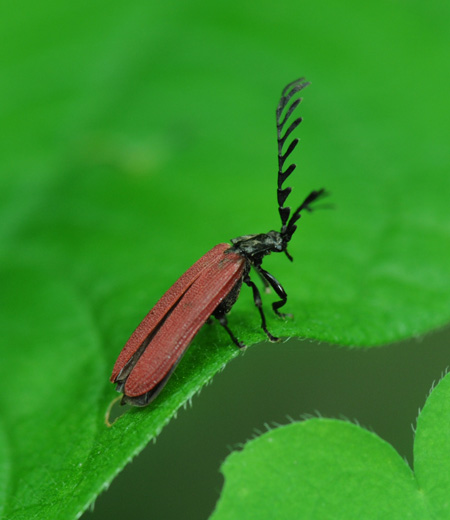 Main region: Honshu, Shikoku and Kyushu.
Main region: Honshu, Shikoku and Kyushu.
Found in woods and its surrounding grassland from flatland to mountains.
Japanese name Beni-botaru literally meaning red-firefly but they are in lycidae family that does not have luminous organs, not in lampyridae family.
As its name states, upper wings are beautiful red like wine red and thorax are black and square so it is easy to distinguish with other species.
They also have big tactile, male antennas are comb-shaped and female ones are toothed like teeth of saw.
Appear from early May.
Are active during daytime and fly to flowers for nectar.
They are toxic and its appealing red is to alarm other species that they are toxic.
Some other species have similar body color.
●Length about 8 to 12 mm
●Season May to about July -
Chrysochroa fulgidissima Buprestidae
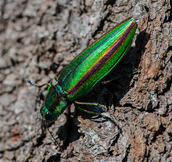
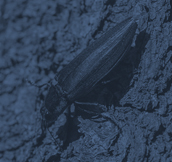 Chrysochroa fulgidissima Buprestidae
Chrysochroa fulgidissima Buprestidae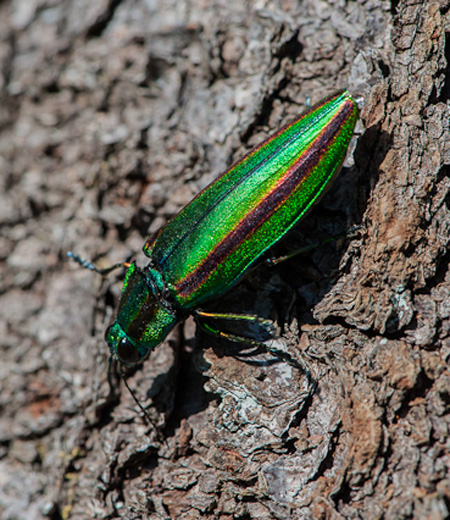 Main Region: Honshu, Shikoku, Kyushu, Sado Island, Tsushima and Tanega Island.
Main Region: Honshu, Shikoku, Kyushu, Sado Island, Tsushima and Tanega Island.
Found in forests and woods from low elevations to mountains.
This species is the one when people call buprestidae and attracted many people from ancient periods.
This species fore wings are used for Tamamushi-nozushi in Horyuji temple.
Body colors are metallic shine green with two red-brown vertical lines.
Also shows bluish and purplish color by light reflection that is the origin of the color Tamamushi-iro (iridescent color).
Are seen during short period in summer, active during daytime and feed on leaves of Chinese hackberry and Japanese zelkova.
Male often fly around these trees and female rest on leaves of these trees.
Larvae grow inside of fallen woods and feed on the woods.
●Length about 30 to 40 mm
●Adults Flight Season July to about August -
Agrypnus binodulus Elateridae
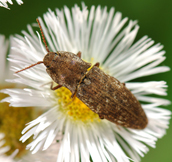
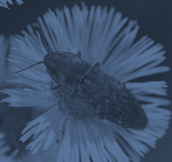 Agrypnus binodulus Elateridae
Agrypnus binodulus Elateridae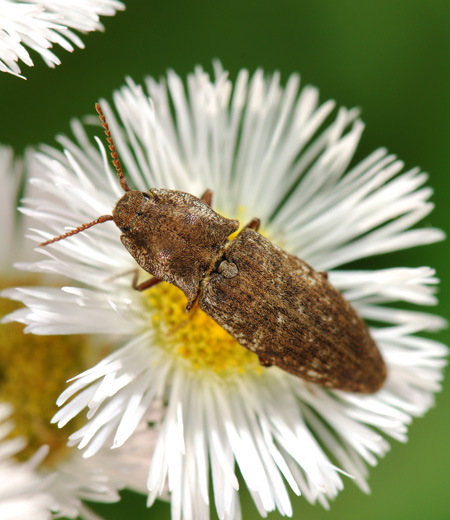 Main Region: Hokkaido, Honshu, Shikoku, Kyushu and Okinawa.
Main Region: Hokkaido, Honshu, Shikoku, Kyushu and Okinawa.
Found in woods and green space from flatlands to low elevations.
When placed on its back, snap and bounce itself into the air.
Body is covered by brown fine hair called scaly hair what looks rusted as Japanese name Sabi-kikori literally meaning rusted woodman states.
Have paired protrusions on the back and middle of thorax.
Are often seen on woods in forests and on leaves in grasslands.
Both larvae and adults are omnivorous and feed on various things including leaves of plants, fallen woods and dead insects.
Adults are attracted to lights at night and feed on sap of sawtooth oak.
●Length about 12 to 16 mm
●Adults Flight Season May to about August -
Coccinella septempunctata (Seven-spot Ladybird) Coccinellidae
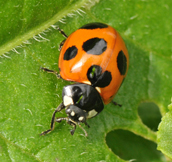
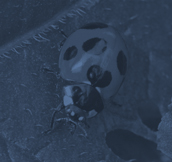 Coccinella septempunctata (Seven-spot Ladybird) Coccinellidae
Coccinella septempunctata (Seven-spot Ladybird) Coccinellidae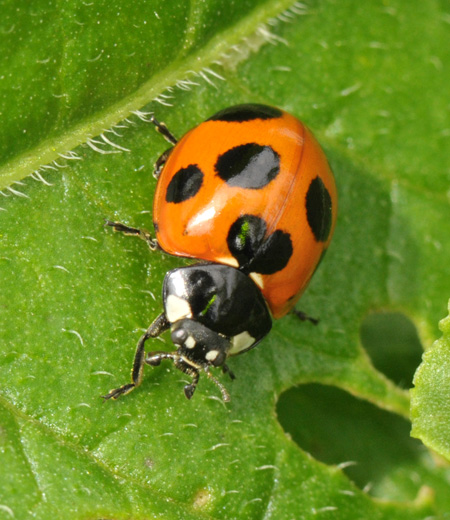 Main Region: Hokkaido, Honshu, Shikoku, Kyushu, Okinawa, Ogawasara Islands and Miyako Island.
Main Region: Hokkaido, Honshu, Shikoku, Kyushu, Okinawa, Ogawasara Islands and Miyako Island.
Found in grasslands and green spaces from flatlands to mountains and also at parks and street trees in cities.
Is the most commonly known insect in Japan.
Have seven black spots on shiny red forewings, hence the Japanese name Nanahoshi-tento seven stars ladybug.
Are seen from spring to early autumn.
Are predatory and feed on plant louse that is widely known.
When noticing dangers, emit smelly and yellow body fluids from joints of legs to protect them.
Larvae also feed on plant louse but body shape is different from adults and is like hairy caterpillars.
●Length about 5 to 8 mm
●Adults Flight Season March to about November -
Aiolocaria hexaspilota Coccinellidae
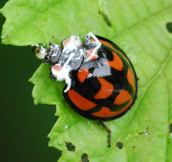
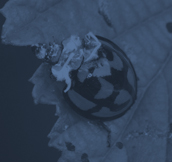 Aiolocaria hexaspilota Coccinellidae
Aiolocaria hexaspilota Coccinellidae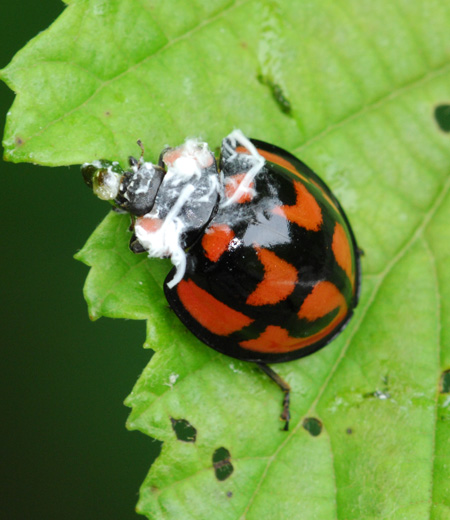 Main Region: Hokkaido, Honshu, Shikoku and Kyushu. Found in woods, green spaces from flatlands to mountains and also along streams in valleys. Is the largest species in Coccinellidae family native to Japan and looks quite strange for ladybugs with the size of larger than 1cm. Fore wings are shiny with red and black complicated patterns like tortoise, hence the Japanese name Kamenoko-tento literally meaning tortoise ladybug. Is seen from early spring to early autumn and adults and larvae feed on larvae of gastrolina depressa and chrysomela populi often found on Japanese walnut and Japanese wingnut and chrysomela vigintipunctata often found on willow. When sensing dangers, exuding smelling body fluids just like most species in ladybugs. In early winter, cluster in gaps of barks or under stones to spend winter.
Main Region: Hokkaido, Honshu, Shikoku and Kyushu. Found in woods, green spaces from flatlands to mountains and also along streams in valleys. Is the largest species in Coccinellidae family native to Japan and looks quite strange for ladybugs with the size of larger than 1cm. Fore wings are shiny with red and black complicated patterns like tortoise, hence the Japanese name Kamenoko-tento literally meaning tortoise ladybug. Is seen from early spring to early autumn and adults and larvae feed on larvae of gastrolina depressa and chrysomela populi often found on Japanese walnut and Japanese wingnut and chrysomela vigintipunctata often found on willow. When sensing dangers, exuding smelling body fluids just like most species in ladybugs. In early winter, cluster in gaps of barks or under stones to spend winter.
●Length about 8 to 12 mm
●Adults Flights Season April to about October -
Meloe coarctatus Meloidae
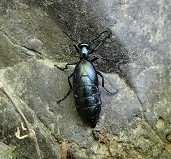
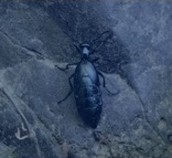 Meloe coarctatus Meloidae
Meloe coarctatus Meloidae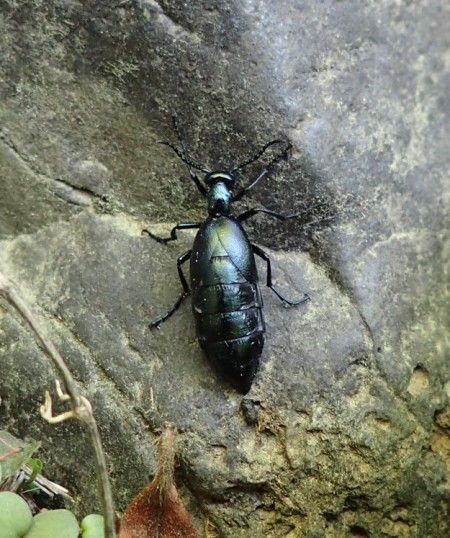 Main Region: Honshu, Shikoku, Kyushu, Tsushima and Sado Island.
Main Region: Honshu, Shikoku, Kyushu, Tsushima and Sado Island.
Found in woods from low elevations to mountains. Have unique body shape with shiny black-indigo blue color, skinny thorax and chubby abdomen.
Wings are deteriorated and fore wings are half the length of abdomen without hind wings, thus are unable to fly.
Walk on grounds and feed on leaves of plants.
Male have unique antennae shape, the middle part is more rounded creating heart-like shape.
Female lay eggs in soils and emerged larvae clime up the plants and reach the flower, hang on to bodies of bees in anthophila family and taken away to their next.
Then feed on eggs and pollen in the nest.
Body fluids are toxic and cause inflammation at a touch.
●Length about 9 to 23 mm
●Adults Flight Season April to about June,about October -
Plesiophthalmus nigrocyaneus Tenebrionidae
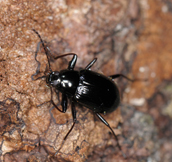
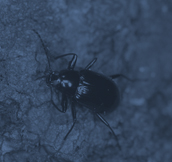 Plesiophthalmus nigrocyaneus Tenebrionidae
Plesiophthalmus nigrocyaneus Tenebrionidae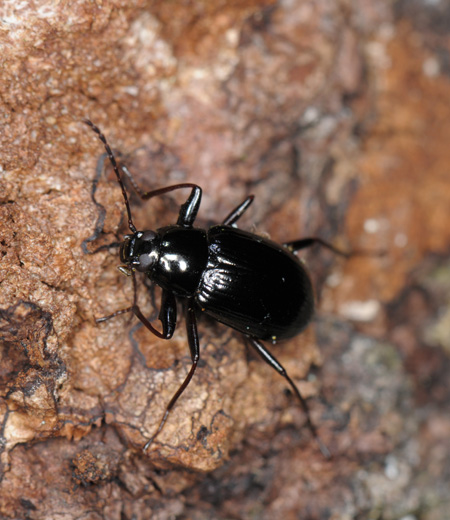 Main Region: Hokkaido, Honshu, Shikoku and Kyushu.
Main Region: Hokkaido, Honshu, Shikoku and Kyushu.
Found in woods from flatlands to forests and also in street trees in cities and in Mt. Takao, one of the insects often seen at mountain trails and around large trees.
Have long legs and frequently walk on trees, hence the Japanese name Ki-mawari tree around.
Body color is mostly black with copperish and indigo bluish shine on the back.
Have many shallow groove-like depressions.
Adults feed on woods, so often found around trunks of trees, fallen trees and dead woods.
Larvae also feed on woods and grow inside of fallen trees and stubs.
●Length about 16 to 20 mm
●Adults Flight Season May to about August -
Arthromacra decora Tenebrionidae
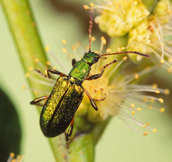
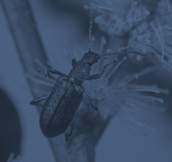 Arthromacra decora Tenebrionidae
Arthromacra decora Tenebrionidae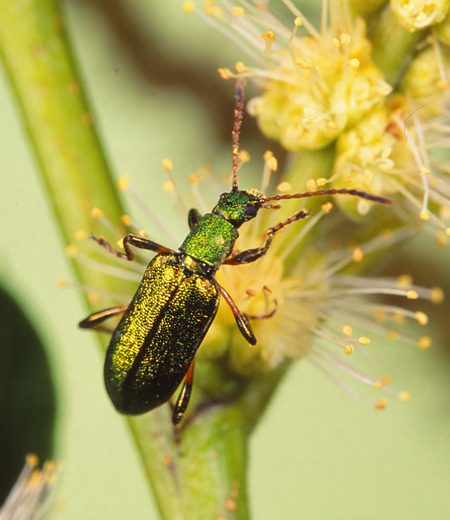 Main Region: Honshu, Shikoku, Kyushu, Tsushima and Yaku Island.
Main Region: Honshu, Shikoku, Kyushu, Tsushima and Yaku Island.
Found in grasslands, green spaces and woods where wild plants grow, from flatlands to low elevations.
Have elongated tubular shaped body are metallic shine bright green from head, thorax to abdomen.
Antennae and legs are light yellow-brown.
Are widely known to insect-fans as metallic colored beautiful beetles like jewel beetles.
Are seen from spring to early summer, often found on flowers of hydrangea luteovenosa and clethra barbinervis and feed on nectar of these flowers.
●Length about 9 to 12 mm
●Adults Flight Season April to about June -
Acrothinium gaschkevitchii Chrysomelidae
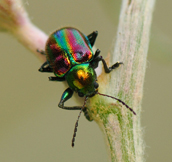
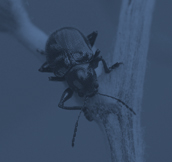 Acrothinium gaschkevitchii Chrysomelidae
Acrothinium gaschkevitchii Chrysomelidae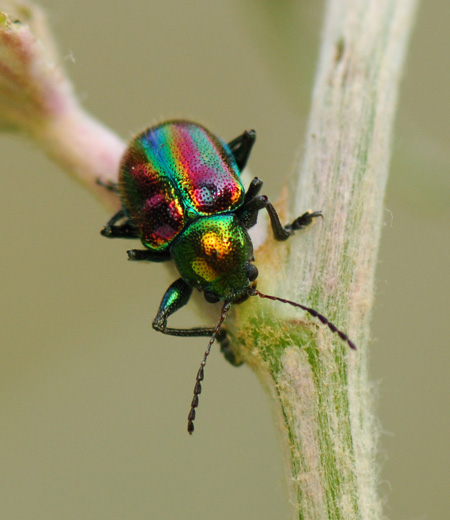 Main Region: Hokkaido, Honshu, Shikoku, Kyushu and Okinawa.
Main Region: Hokkaido, Honshu, Shikoku, Kyushu and Okinawa.
Found in woods and surrounding grasslands from flatlands to mountains and also in croplands.
Body color varies among individuals of the same species.
Most of them have red-copper on upper parts of fore wings and metallic green on the rest as the Japanese name Aka-gane-saru-hamushi literally meaning red copper monkey chrysomelidae states.
Body color looks different by viewing angles and is very beautiful.
Are seen from spring to summer and feed on leaves of plants in vitaceae family including Vitis ficifolia var. lobata, Corylopsis spicata Sieb. et Zucc., and mint and often found on these plants.
Larvae feed on roots of plants that adults feed on.
Both larvae and adults are known as pests for plants in vitaceae family.
●Length about 5 to 7 mm
●Adults Flight Season May to about August -
Gallerucida bifasciata Chrysomelidae
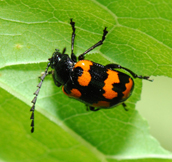
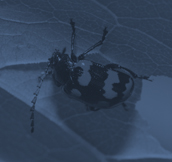 Gallerucida bifasciata Chrysomelidae
Gallerucida bifasciata Chrysomelidae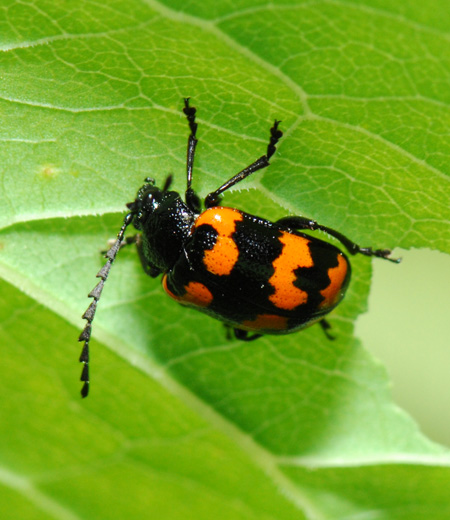 Main Region: Hokkaido, Honshu, Shikoku and Kyushu.
Main Region: Hokkaido, Honshu, Shikoku and Kyushu.
Found in forest, grasslands, croplands and grassy areas on riverbeds from flatlands to mountains.
Is a family of chrysomelidae with ladybug-like patterns.
Body color is shiny black on head and thorax and black on fore wings with orange spots both on upper and bottom parts.
This pattern varies among individuals of the same species, some are large and some have small patterns.
Have distinct thick and long antennae.
Species in chrysomelidae family eat leaves of plants but varies by different species.
This species feeds on Japanese knotweed and are often seen on these leaves.
Also feed on leaves of rumex japonicus and common sorrel.
●Length about 7 to 9 mm
●Adults Flight Season April to about September -
Cassida vespertina Chrysomelidae

 Cassida vespertina Chrysomelidae
Cassida vespertina Chrysomelidae Main Region: Honshu, Shikoku, Kyushu and Okinawa.
Main Region: Honshu, Shikoku, Kyushu and Okinawa.
Found in woods and green space from flatlands to mountains.
Most species in cassidinae edges of thorax and fore wings arch out, creating pointed hat or helmet shape which can cover entire antennae and legs (There is a species called aspidomorpha indica boheman).
When looking at this species from above, body shape is almost square with bumpy surface.
Black patterns on fore wings are stretched to front edges to bottom edges, creating turtle-like shape.
Both larvae and adults feed on leaves of clematis apiifolia.
Female lay eggs and paste own dungs around eggs.
Larvae grow with empty shell on its back.
●Length about 4 to 7 mm
●Adults Flight Season May to about September -
Thlaspida cribrosa Chrysomelidae
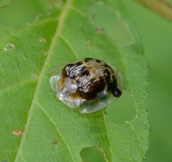
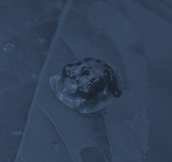 Thlaspida cribrosa Chrysomelidae
Thlaspida cribrosa Chrysomelidae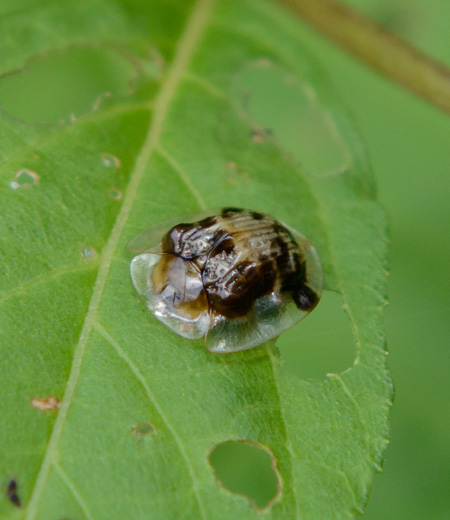 Main Region: Honshu, Shikoku, Kyushu, Okinawa, Tsushima and Yaku Island.
Main Region: Honshu, Shikoku, Kyushu, Okinawa, Tsushima and Yaku Island.
Found in green space and grasslands from flatlands to mountains.
Arched out areas are mostly transparent which looks like covered with plastic cover.
Have paired black spots along edges of lower parts of fore wings and dark areas of abdomen, creating one thick belt-like patterns and remind people of the letter one in Chinese character.
Are seen from spring and feed on leaves of Japanese beautyberry, callicarpa dichotoma and callicarpa japonica form.
Albibacca and often found on the back of leaves of these plants.
Larvae also feed on leaves of these plants.
Larvae have habit of attaching dungs and empty shells at the tip of tails.
●Length about 8 to 9 mm
●Adults Flight Season April to about October -
Leptura ochraceofasciata Cerambycidae
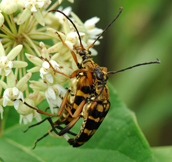
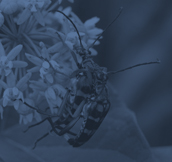 Leptura ochraceofasciata Cerambycidae
Leptura ochraceofasciata Cerambycidae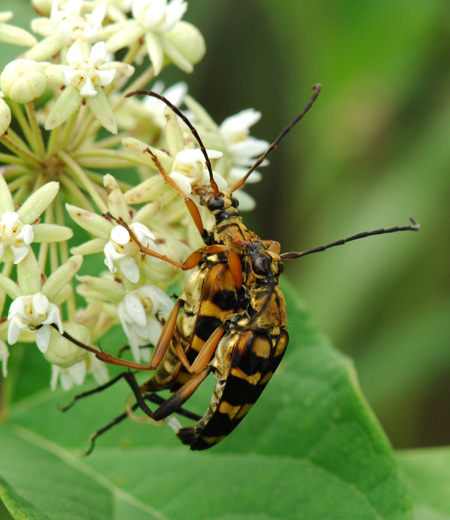 Main region: Hokkaido, Honshu, Shikoku, Kyushu, northern islands of Izu Islands, Rishiri Island, Sado Island, Oki Island and Goto Islands.
Main region: Hokkaido, Honshu, Shikoku, Kyushu, northern islands of Izu Islands, Rishiri Island, Sado Island, Oki Island and Goto Islands.
Found in woods and grassland from flatlands to mountains.
Japanese name Yotsusuji-hana-kamikiri literally meaning four lines flower cerambycidae was named because there is four yellow-brown to white four lines on hard outer wings.
Have yellow-brown legs and skinny body that simulates the appearance of bees.
Are seen from mid-June. Adults are a subfamily of lepturinae that feed on pollen and nectar of flowers, and fly to hydrangeas, hydrangea paniculata, Japanese chestnuts, clethra barbinervis and cornus controversa.
The patterns on the body of some species resemble clytini tribe but this species is easily distinguished by skinny thorax.
Larvae feed on trunk of needle leaf trees including yezo spruce and Japanese red pine.
●Length about 12 to 20 mm.
●Adult Flight Season June to about September
